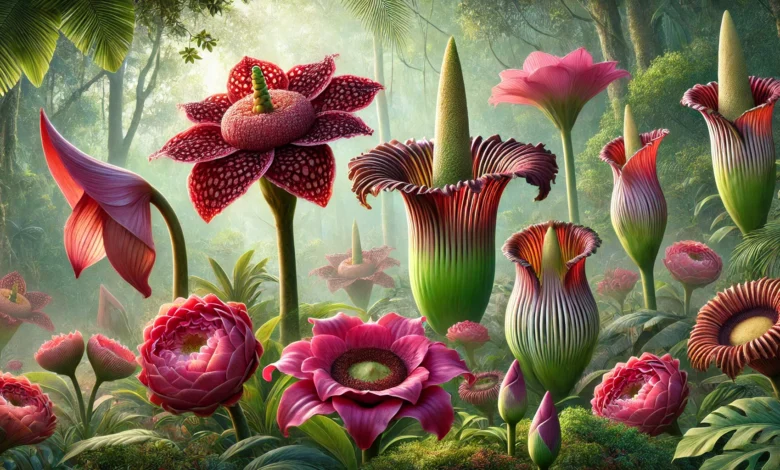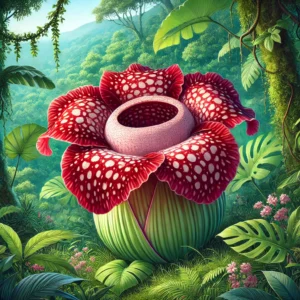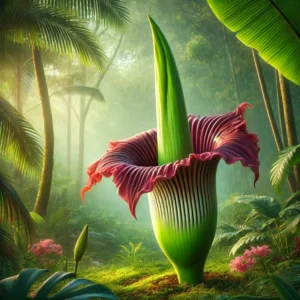
Introduction to Giant Flowers.
The world biggest Flowers
Giant flowers, often referred to as the remarkable giants of the plant kingdom, represent a captivating category of flowering plants that feature blooms of extraordinary size. While there is no universally accepted definition of what constitutes a ‘giant flower,’ these specimens typically exceed standard dimensions significantly, often measuring over ten inches in diameter. The sheer scale of these flowers not only provides a stunning visual appeal but also serves various ecological functions within their respective ecosystems.
The significance of large flowers extends beyond aesthetics; they play a crucial role in their environments by attracting specific pollinators. Many giant flowers have evolved intricate characteristics, including vibrant colors and enticing scents, to draw in bees, butterflies, and other creatures essential for the continuation of their species. These traits enhance their standing in biodiversity, making them vital players in sustaining healthy ecosystems. For instance, the corpse flower (Amorphophallus titanum) is renowned not only for its gigantic size but also for its unique odor, which mimics that of decaying flesh, thus attracting carrion beetles and other scavengers for pollination.
Moreover, giant flowers are often a focal point of research in botanical sciences, providing insights into plant growth and adaptation mechanisms. The study of these magnificent blooms contributes to our understanding of evolutionary biology and can inspire conservation efforts for habitats lacking these iconic flora. As we explore specific giant flowers from around the globe, it becomes evident that their attributes extend far beyond mere size, embodying complex relationships within their ecosystems and highlighting their essential functions within the plant kingdom. This discussion will unveil various specimens, showcasing their unique characteristics and ecological significance.

Rafflesia arnoldii: the world biggest flower
Rafflesia arnoldii, often hailed as the largest flower in the world, presents an extraordinary marvel of botanical beauty and adaptation. Native to the rainforests of Borneo and Sumatra, this remarkable plant has captivated the curiosities of scientists and nature enthusiasts alike due to its impressive dimensions, with blooms reaching up to three feet in diameter. The flower typically emerges from a large bud, which can take months to develop, culminating in a spectacular display that commands attention in its lush tropical surroundings.
In terms of physical attributes, Rafflesia arnoldii is characterized by its striking red petals adorned with white spots, which serve a purpose beyond mere aesthetics. These bold colors and patterns attract pollinators, primarily carrion flies, which are drawn to the flower’s pungent odor resembling that of decaying flesh. This unique strategy enables the parasitic plant to reproduce, despite its lack of leaves, stems, or roots typical of most plants. Instead, Rafflesia arnoldii relies entirely on its host vine, Tetrastigma, drawing nutrients and water to sustain its growth.
The life cycle of Rafflesia arnoldii is equally fascinating. After the pollination process, the flower produces a fruit that releases seeds, which can spread within a range of host vines. The seeds then germinate and attach to the host, where they mature into new buds. However, Rafflesia arnoldii faces numerous challenges, including habitat loss due to deforestation and climate change. These environmental pressures threaten the delicate balance required for its survival, highlighting the importance of conservation efforts aimed at preserving this iconic flower and its habitat.
Corpse Flower: The Stinky Giant

Among the remarkable giants of the floral world, the corpse flower (Amorphophallus titanum) stands out, both in size and in its distinctive odor. This impressive plant, native to the tropical rainforests of Sumatra, Indonesia, can reach heights of over ten feet, making it one of the largest flowering structures on the planet. However, it is its infamous smell, likened to that of decomposing flesh, that has earned it the moniker of ‘corpse flower’. This potent odor serves a purpose beyond mere astonishment; it plays a critical role in the plant’s reproductive strategy.
The flowering of the corpse flower is a rare event, occurring approximately once every 7 to 10 years, although environmental conditions can influence this frequency. During its bloom, the corpse flower emits its characteristic stench to attract specific pollinators, particularly carrion beetles and certain flies, which are naturally drawn to rotting meat. This fascinating ecological relationship highlights the unique adaptations of the corpse flower, allowing it to thrive in a competitive environment where other plants also vie for the attention of pollinators.
Cultural perceptions of the corpse flower vary widely. In some contexts, it is celebrated as a botanical marvel, attracting visitors to botanical gardens during blooming events. These events often generate significant public interest, with crowds gathering to witness the rare spectacle. However, the overwhelming odor can also evoke strong reactions, with many visitors expressing both fascination and disgust. As the bloom progresses, the scent can become even more potent before eventually fading away, leaving behind a natural phenomenon that shares a deep connection with biodiversity and the intricate web of life within its native habitat.
Other Notable Large Flowers
The world is home to an astonishing variety of large flowers, each with its unique features and ecological significance. Among these, the Talipot Palm flower (Corypha umbraculifera) stands out due to its remarkable size and impressive growth cycle. This palm species, native to the tropical regions of India and Sri Lanka, can produce flower clusters that extend over 25 feet in height. The Talipot Palm only flowers once in its lifetime, typically after 30 to 80 years of growth, culminating in a spectacular display, followed by the tree’s death. This infrequent yet grand event recasts a spotlight on the mysteries of plant life cycles while showcasing nature’s grandeur.
Another striking specimen is the Victoria amazonica, the largest freshwater lily in the world. This immense lily can grow leaves that measure up to 10 feet in diameter, supported by a network of strong ribs that allow them to float on water surfaces within the Amazon River basin. Typically found in slow-moving waters, the Victoria amazonica is known for its beautiful blossoms, which can change colors from white during the night to pink by day. The plant’s unique adaptations enable it to thrive in its aquatic habitat, while also supporting ecosystems by providing habitat for various aquatic species.
These large flowers not only showcase the diversity of the plant kingdom but also serve vital roles in their respective ecosystems. The Talipot Palm flower and Victoria amazonica contribute to the vibrant tapestry of the natural world, attracting pollinators and providing essential habitats, while their immense size captivates the interest of botanists and nature enthusiasts alike. Each remarkable giant flower adds to the mosaic of life on Earth, exemplifying nature’s artistic prowess and evolutionary ingenuity.
Cultural Significance of Giant Flowers
Giant flowers have captured the imagination of various cultures around the globe, leading to rich symbolism and significance attributed to these remarkable natural giants. In many societies, the size and unique characteristics of large flowers often symbolize beauty, love, and the transient nature of life. Their striking appearance has inspired artists, poets, and storytellers throughout history, making them central to various forms of artistic expression. For instance, the enormous blooms of the Rafflesia arnoldii, known for their pungent odor, have found their way into the folklore of Southeast Asia, representing both allure and danger due to their captivating yet repulsive scent.
In Japan, the cherry blossom, while not gigantic in comparison, carries profound cultural significance and is celebrated during Hanami, a festival that marks the arrival of spring. This tradition highlights the beauty of flowers, including those that grow to impressive sizes, as a reflection of mortality and the fleeting nature of life. They serve as reminders of the impermanence of existence, encapsulating the cultural ethos of appreciating beauty while recognizing its temporality.
Moreover, enormous flowers frequently appear in rituals and celebrations worldwide. In some indigenous cultures, large blooms are used in ceremonial practices, symbolizing fertility and prosperity. They are often incorporated into decorative arrangements during festivities, conveying auspicious meanings and enhancing the visual splendor of the events. Artistic depictions of giant flowers can also be observed in literature and paintings, where they embody themes of love, reverence, and nature’s grandeur. Therefore, the cultural significance of giant flowers transcends mere aesthetics; it intertwines with societal values, beliefs, and customs, illustrating the intricate relationship between humans and nature.
Ecological Importance of Large Flowers
Large flowers play a significant role in maintaining ecological balance within their respective ecosystems. These remarkable giants contribute to the intricate web of life, primarily through their interactions with various pollinators. For instance, specific species of giant flowers, such as the Rafflesia arnoldii, which is known for its immense size and distinctive odor, attract particular pollinators, including bees and carrion beetles. The scent emanating from these flowers mimics that of decaying organic matter, thereby drawing in creatures that would otherwise be disinterested in traditional flora.
This unique relationship between large flowers and their pollinators emphasizes their function as critical nodes within ecosystems. By facilitating the transfer of pollen, these plants not only ensure their reproduction but also directly contribute to the genetic diversity of neighboring flora. As large flowers bloom and decay, they enrich the soil with organic material, fostering a diverse range of plant life, which can lead to enhanced biodiversity in local habitats. Furthermore, this diversity benefits countless species, from insects to larger fauna, that rely on a rich tapestry of plants for food and shelter.
<pin a=”” adaptations=”” addition=”” also=”” and=”” animal=”” area.=”” attract=”” behavior=”” between=”” biota=”” can=”” develop=”” diversifying=”” draw=”” dynamics=”” ecological=”” ecosystem.
Conservation Challenges
Large flowering plants, often celebrated for their impressive size and beauty, face a multitude of conservation challenges that threaten their survival in the wild. One of the primary threats is habitat loss, driven largely by human activities such as urban development, agriculture, and deforestation. As natural habitats are fragmented and diminished, many species struggle to find the space needed for their growth and reproduction. This loss of habitat not only reduces their populations but also disrupts the ecological balances that they help maintain.
In addition to habitat loss, climate change poses a significant risk to large flowering plants. Changes in temperature and precipitation patterns can alter the delicate conditions necessary for these plants to thrive. Warmer temperatures may lead to increased evaporation and reduced water availability, which is critical for these species, many of which are already adapted to specific climate zones. Furthermore, extreme weather events, such as heavy storms or prolonged droughts, can have devastating effects on the survival of these giants of the plant world.
Illegal collection is another pressing concern for many rare flowering plants. The demand for exotic specimens in the horticultural trade can lead to unsustainable harvesting practices that threaten their populations in the wild. Such activities not only reduce the number of individuals left in their natural habitats but can also lead to the extinction of species that are particularly vulnerable.
To combat these challenges, various conservation efforts are underway. Organizations are working to create protected areas that serve as sanctuaries for large flowering plants, ensuring that they remain undisturbed and can propagate naturally. Additionally, awareness campaigns aiming to educate the public about the importance of these plants are crucial in reducing illegal collection and promoting sustainable practices among horticulturists and collectors. Continuous research is also vital to understand better the specific needs of these species and to inform conservation strategies effectively. Through these combined efforts, there is hope for the preservation of these remarkable giants of the natural world.
How to Grow Your Own Giant Flowers
Growing giant flowers can be a rewarding and visually stunning endeavor for any garden enthusiast. To successfully cultivate these remarkable plants, it is crucial to start with the right species. Popular options include the **Titan Arum**, known for its impressive size and distinct odor, and the **Giant Hibiscus**, which produces stunning blooms that can reach up to a foot in diameter. Researching the specific requirements of each species is the first step toward ensuring successful growth.
Ideal growing conditions are another vital aspect to consider. Most giant flowers thrive in full sun, requiring at least six hours of direct sunlight daily. Ensuring that the soil is well-draining is essential as it helps prevent root rot, a common issue among large blooms. Consider testing your soil’s pH level; most giant flowers prefer a slightly acidic to neutral pH of around 6 to 7. Amending the soil with organic matter, such as compost, can enhance soil fertility and structure, providing a nurturing environment for your plants.
Care tips are equally important during the growth cycle. Giant flowers often require substantial water, especially during dry spells, making consistent hydration crucial. Mulching can help retain moisture and suppress weeds, allowing the flowers to flourish. Additionally, fertilizing periodically with a balanced fertilization approach will support healthy growth and vibrant blooms. Consider using slow-release fertilizers to provide nutrients over an extended period.
Lastly, to ensure successful blooms, regular pruning and deadheading can promote new flower production and prevent disease. Keep an eye out for pests that could hinder growth, applying organic pest control methods as necessary. With attention to these key factors, growing giant flowers can transform your garden into a spectacle of nature’s remarkable giants.
Conclusion: Celebrating Nature’s Marvels
As we conclude our exploration of the world’s largest flowers, it is imperative to reflect upon the exceptional beauty and ecological significance these botanical giants offer. From the renowned Rafflesia arnoldii, known for its staggering size and unique odor, to the enchanting Corpse Flower, each of these species plays a vital role in their respective ecosystems. Their existence not only captivates naturalists and casual observers alike, but they also serve critical functions such as attracting pollinators and sustaining local wildlife.
Giant flowers exemplify the diverse wonders of nature and remind us of the intricate relationships that contribute to biodiversity. Their grandeur encourages admiration and respect for the natural world, underscoring the importance of conservation efforts. Many of these remarkable plants face threats from habitat loss, climate change, and exploitation, making it essential for individuals and communities to advocate for their protection. Engaging with nature, learning about these species, and supporting conservation initiatives will contribute to ensuring their survival for future generations.
We invite our readers to delve deeper into the fascinating world of giant flowers. Share your experiences with these remarkable plants, whether through personal stories or photographs taken during your explorations. By fostering a shared appreciation for these natural marvels, we can collectively celebrate and safeguard the wonders of the plant kingdom. Ultimately, recognizing and valuing the unique beauty of giant flowers allows us to connect more profoundly with nature, inspiring a new generation to cherish and protect the environment that sustains us all.